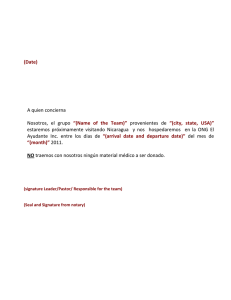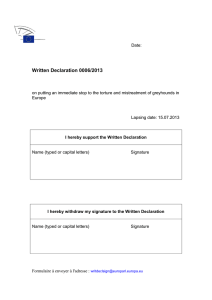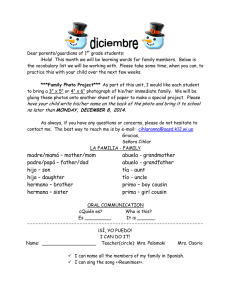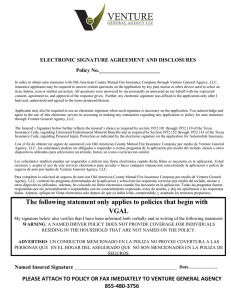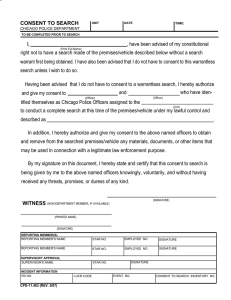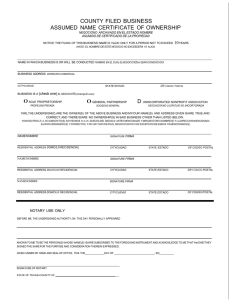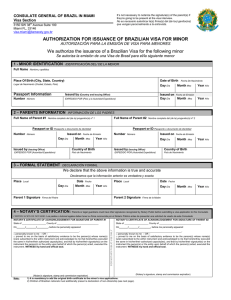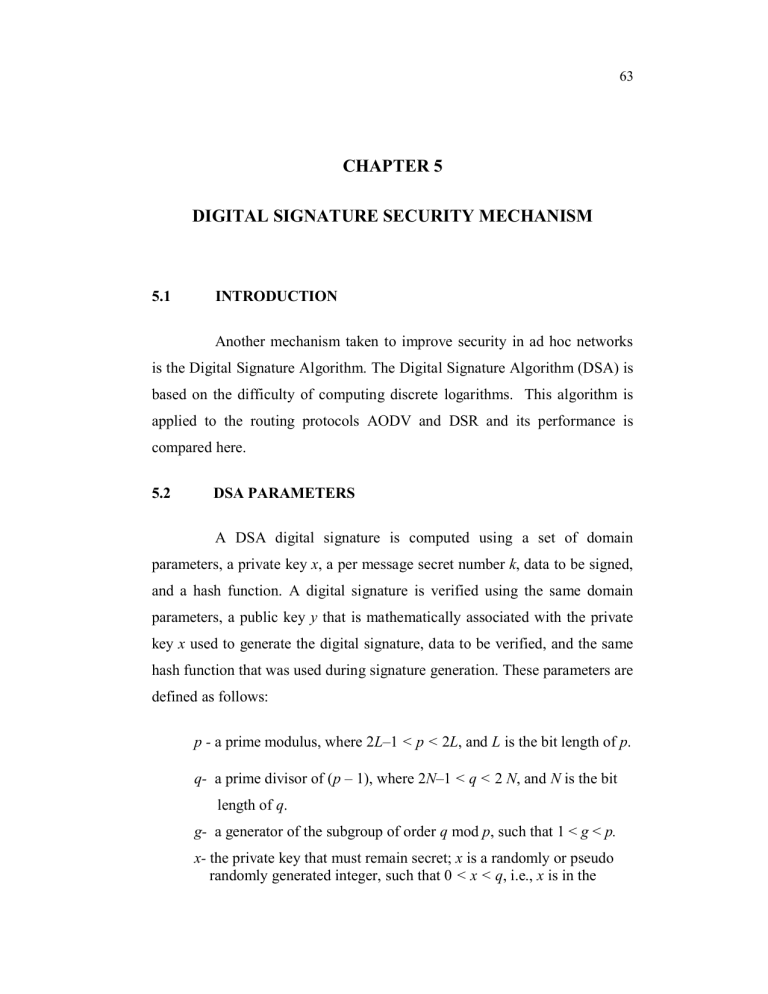
63 CHAPTER 5 DIGITAL SIGNATURE SECURITY MECHANISM 5.1 INTRODUCTION Another mechanism taken to improve security in ad hoc networks is the Digital Signature Algorithm. The Digital Signature Algorithm (DSA) is based on the difficulty of computing discrete logarithms. This algorithm is applied to the routing protocols AODV and DSR and its performance is compared here. 5.2 DSA PARAMETERS A DSA digital signature is computed using a set of domain parameters, a private key x, a per message secret number k, data to be signed, and a hash function. A digital signature is verified using the same domain parameters, a public key y that is mathematically associated with the private key x used to generate the digital signature, data to be verified, and the same hash function that was used during signature generation. These parameters are defined as follows: p - a prime modulus, where 2L–1 < p < 2L, and L is the bit length of p. q- a prime divisor of (p – 1), where 2N–1 < q < 2 N, and N is the bit length of q. g- a generator of the subgroup of order q mod p, such that 1 < g < p. x- the private key that must remain secret; x is a randomly or pseudo randomly generated integer, such that 0 < x < q, i.e., x is in the 64 range [1, q–1]. y- the public key, where y = gx mod p. k- a secret number that is unique to each message; k is a randomly or pseudo randomly generated integer, such that 0 < k < q, i.e., k is in the range [1, q–1]. 5.3 DSA SIGNATURE GENERATION Let N be the bit length of q. Let min(N, outlen) denote the minimum of the positive integers N and outlen, where outlen is the bit length of the hash function output block. The signature of a message M consists of the pair of numbers r and s that is computed according to the following equations: r = (gk mod p) mod q. z = the leftmost min(N, outlen) bits of Hash(M). s = (k 1 (z + xr)) mod q. When computing s, the string z obtained from Hash(M) shall be converted to an integer. Note that r may be computed whenever k, p, q and g are available, e.g., whenever the domain parameters p, q and g are known, and k has been pre-computed, r may also be pre-computed, since knowledge of the message to be signed is not required for the computation of r. Pre-computed k, k-1 and r values shall be protected in the same manner as the the private key x until s has been computed. The values of r and s shall be checked to determine if r = 0 or s = 0. If either r = 0 or s = 0, a new value of k shall be generated, and the signature shall be recalculated. It is extremely unlikely that r = 0 or s = 0 if signatures are generated properly. The signature (r, s) may be transmitted along with the message to the verifier. 65 5.4 DSA SIGNATURE VERIFICATION AND VALIDATION Signature verification may be performed by any party (i.e., the signatory, the intended recipient or any other party) using the signatory’s public key. A signatory may wish to verify that the computed signature is correct, perhaps before sending the signed message to the intended recipient. The intended recipient (or any other party) verifies the signature to determine its authenticity. Prior to verifying the signature of a signed message, the domain parameters, and the claimed signatory’s public key and identity shall be made available to the verifier in an authenticated manner. The public key may, for example, be obtained in the form of a certificate signed by a trusted entity (e.g., a CA) or in a face-to-face meeting with the public key owner. Let M , r , and s be the received versions of M, r, and s, respectively; let y be the public key of the claimed signatory; and let N be the bit length of q. Also, let min(N, outlen) denote the minimum of the positive integers N and outlen, where outlen is the bit length of the hash function output block. The signature verification process is as follows: 1. The verifier shall check that 0 < r < q and 0 < s < q; if either condition is violated, the signature shall be rejected as invalid. 2. If the two conditions in step 1 are satisfied, the verifier computes the following: w = (s )–1 mod q. z = the leftmost min(N, outlen) bits of Hash(M ). u1 = (zw) mod q. 66 u2 = ((r )w) mod q. v = (((g)u1 (y)u2) mod p) mod q. The string z obtained from Hash(M ) shall be converted to an integer. 3. If v = r , then the signature is verified. For a proof that v = r when M = M, r = r, and s = s. 4. If v does not equal r , then the message or the signature may have been modified, there may have been an error in the signatory’s generation process, or an imposter (who did not know the private key associated with the public key of the claimed signatory) may have attempted to forge the signature. The signature shall be considered invalid. 5.5 SIMULATION ENVIRONMENT The simulation environment to carry out the Digital Signature Algorithm in the protocols AODV and DSR is similar to that of Dual hash authentication and Triple Hash Authentication. 5.6 PERFORMANCE ANALYSIS – DSA Vs AODV and DSR 5.6.1 Packet Delivery Ratio Figure 5.1 shows the effect of increase in number of nodes on Packet Delivery Ratio (PDR) of AODV, DSR and DSA with a mobility speed of 20m/s. As the number of nodes increases, all the three protocols show improvement in PDR since the packets are delivered in a faster and efficient manner. Here DSR protocol is performing better than AODV and DSA algorithm performs better when applied to DSR. 67 350 300 250 200 DSR AODV DSA 150 100 50 0 10 20 30 40 50 60 70 Number of Nodes Figure 5.1 Nodes Vs Packet Delivery Ratio 5.6.2 Control Overhead Figure 5.2 shows the Nodes Vs Control overhead for AODV, DSR and DSA when the mobility of nodes is at 20 m/s. In all the cases the control packets increase when the number of nodes increases. DSA has less control packets compared to AODV due to the secure algorithm. Control overhead is increased by almost 25% in the case of both DSR and DSA and by 26 % in the case of AODV. 68 900 800 700 600 500 DSR AODV DSA 400 300 200 100 0 10 20 30 40 50 60 70 Number of Nodes Figure 5.2 Nodes Vs Control Overhead 5.6.3 Average End-to-End Delay Nodes Vs Average end-to-end delay graph for AODV, DSR and DSA is shown in figure 5.3. In all the three cases, Delay has been reduced when the number of nodes increases. Delay has been reduced by 1.5% in the case of DSA and by 0.01% when compared to DSR protocol. 0.012 0.01 0.008 DSR AODV DSA 0.006 0.004 0.002 0 10 20 30 40 50 60 70 Number of Nodes Figure 5.3 Nodes Vs Average end-to-end delay 69 5.6.4 Throughput Figure 5.4 shows the Nodes Vs Throughput for AODV, DSR and DSA. Throughput has been increased substantially in all the three cases. The throughputs of DSR and DSA are almost same, when the number of nodes increases. 4800 4600 4400 4200 DSR AODV DSA 4000 3800 3600 3400 10 20 30 40 50 60 70 Number of Nodes Figure 5.4 Nodes Vs Throughput 5.6.5 Route Acquisition Time Figure 5.5 shows about the route acquisition time of the DSR, AODV and DSR with DSA. DSR with DSA is giving better performance than AODV and DSR when the nodes are increased from 10 to 70. 70 0.012 0.01 0.008 DSR AODV 0.006 DSA 0.004 0.002 0 10 20 30 40 50 60 70 Number of Nodes Figure 5.5 Nodes Vs Route Acquisition Time 5.7 SUMMARY In this chapter, the Digital Signature security mechanism has been proposed for the routing protocol DSR. The performance of the protocols AODV, DSR and DSR with the implementation of DSA has been analyses with node mobility at a speed of 20 m/s. The parameters analysed were Packet Delivery Ratio, Control Overhead, End-to-end delay, Throughput and Route Acquisition Time. The results have shown that DSR with DSA has performed better in all the parameters.
